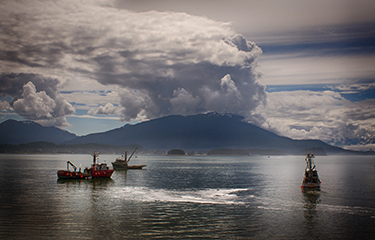As Alaska’s salmon fishing season starts to wrap up, numbers are indicating a relatively poor showing overall.
While landings and fish tickets continued to trickle in, preliminary numbers from the Alaska Department of Fish and Game showed Alaskan salmon fishermen harvested around 113 million fish on the 2020 season, falling well short of the pre-season projection of nearly 133 million fish. It makes the season the fifth-worst even-year harvest since 1975, according to Garrett Evridge, chief economist for the McDowell Group.
“If you zoom out and look at where we are compared to other even numbered years, it’s a pretty difficult season just in terms of total harvest. A harvest of 112 [or] 113 million fish is down pretty substantially from where we usually are in an even-numbered year,” Evridge told SeafoodSource.
Bristol Bay sockeye salmon, a bright spot again in the overall Alaska salmon picture, accounted for nearly 40 million of the 113 million all-species catch. Meanwhile, the statewide sockeye catch was just 45 million.
“If you take Bristol Bay out of the equation and just look at these other runs, it’s the worst sockeye run we’ve seen since 1976,” Evridge said.
The famous Copper River sockeye barely made minimum escapement this season with almost no fishing, and sockeye saw over 60 percent drops in Cook Inlet, Prince William Sound, and Southeast.
Chignik fishermen did not put their nets in the water, while salmon across all species continued to plummet in the Arctic-Yukon-Kuskokwim Region.
“The AYK is difficult. We’re not talking about a lot fish there, even in a normal year it’s just a few million fish, but the value of a single fish there to those communities is so much more,” Evridge said.
Regions across the state saw drops in numbers of chums, with a statewide year-on-year decline of nearly 60 percent. In recent years in Southeast Alaska, for example, large hatchery chums harvests have cushioned low pink runs. But this season Southeast harvested just 4.5 million chums, down from 11.5 million in 2018. Prices, too, are down across the board, a combination, analysts think, of processors footing large COVID-19 bills and the effects of Chinese tariffs.
Troy Thynes, ADFG’s salmon and herring management coordinator for Southeast, told SeafoodSource the equation is adding up to a bottom line that is just over one-third of historical averages.
“Southeast-wide we’re looking at an ex-vessel value of USD 40 million [EUR 34.4 million] for all species and all gear types. The recent 10-year average is USD 112.9 million [EUR 97.1 million] and this year is the lowest value since 1976,” Thynes told SeafoodSource.
The harvest of 7.8 million pinks is also the lowest Southeast Alaska has seen since 1976, and Thynes added that pinks are selling at just USD 0.22 [EUR 0.18] a pound, down from USD 0.35 [EUR 0.30] a pound.
Last week, the Southeast borough of Petersburg joined Cordova – homeport for the Copper River fishery – and Chignik with requests for Governor Mike Dunleavy to declare fisheries disasters in their respective regions.
“This year’s prices are down. I’m not aware of any price in any fishery that is up from last year,” Evridge said.
He did add that the murky markets from COVID-19 chaos could yield bumps in some salmon prices as the winter draws on.
“It’s such an unusual year that our model of how things work, and how they’ve worked in the past, I just don’t know if they work anymore, especially for sockeye. The markets for sockeye did improve over the summer,” Evridge said.
And while Thynes said it would undoubtedly be a tough winter for many fishermen, he said Southeast made its escapement goals for most pink runs.
“If you want to look at the positives, we made our escapement goals or at least improved on them from the parent-year 2018 for pink salmon. There were some indications that marine survival for pink salmon was better than recent years, so that’s a positive indication,” Thynes said.
Kodiak was another bright spot, with a catch of around 22 million pinks representing a 260 percent increase over last year, but Evridge said isolated bumps like the one in the Kodiak did not make up for low runs elsewhere.
“There were more negatives than positives. Whether you’re talking about Arctic-Yukon-Kuskokwim, or Chignik, or sockeye, or coho, or chum salmon,” Evridge said.
Coho, Evridge added, was also down to levels not seen since the mid-1970s.
Photo courtesy of Maxim Gorishniak/Shutterstock







